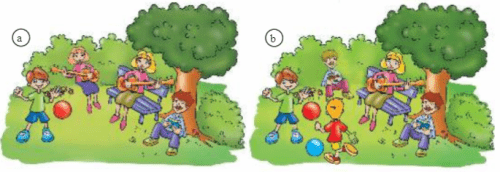Lesson 3
1. Ask and answer, as in the examples. Спросите и ответьте, как в примерах.

1. (dark hair)
A: Has she got dark hair?
B: No, she hasn’t. She’s got red hair.
2. (a dog)
A: Has he got a dog?
B: Yes, he has.
3. (a bike)
4. (a long tail)
5. (caps)
6. (a car)
Ответ:
1. A: Has she got dark hair?
B: No, she hasn’t. She’s got red hair.
2. A: Has he got a dog?
B: Yes, he has.
3. A: Has she got a bike?
B: No, she hasn't. She's got a ball.
4. A: Has it got a long tail?
B: Yes, it has.
5. A: Have they got caps?
B: Yes, they have.
6. A: Has he got a car?
B: No, he hasn't. He's got a bike.
Перевод:
1. A: У нее темные волосы?
B: Нет. У нее рыжие волосы.
2. A: У него есть собака?
B: Да, есть.
3. A: У нее есть велосипед?
B: Нет. У нее есть мяч.
4. A: У него длинный хвост?
B: Да.
5. A: У них есть у них кепки?
В: Да.
6. A: У него есть машина?
B: Нет. У него есть велосипед.
2. Spot the differences. Найдите отличия.

1. (man) In picture a, there’s one man. In picture b, there are two men.
2. (woman)
3. (child)
1. (мужчина) На рисунке а − один мужчина. На рисунке b − двое мужчин.
2. (женщина)
3. (ребенок)
Ответ:
1. In picture a, there’s one man. In picture b, there are two men.
2. In picture a, there are two women. In picture b, there's one woman.
3. In picture a, there’s one child. In picture b, there are two children.
Перевод:
1. На картинке a один мужчина. На картинке b двое мужчин.
2. На картинке a две женщины. На картинке b − одна женщина.
3. На картинке a один ребенок. На картинке b двое детей.

